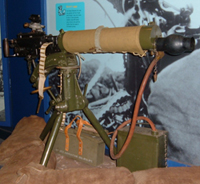Museum of the Manchester Regiment Object Focus
The Vickers Machine Gun
 The Vickers machine gun is an important part of British military history. It was officially introduced into service in 1912 and was declared obsolete in 1968. That’s more than five decades of use! The Vickers is modelled on an earlier machine gun, called the Maxim. Vickers made some modifications to the Maxim, mainly to reduce weight, and a new gun was born.
The Vickers machine gun is an important part of British military history. It was officially introduced into service in 1912 and was declared obsolete in 1968. That’s more than five decades of use! The Vickers is modelled on an earlier machine gun, called the Maxim. Vickers made some modifications to the Maxim, mainly to reduce weight, and a new gun was born.
The gun is water-cooled, which is why there is a large ‘jacket’ around the barrel, and was capable of firing 450 to 500 rounds per minute. If the gun fired 500 to 600 rounds in rapid fire, the water in the jacket would begin to boil. The range of the Vickers was quite far, being able to provide indirect fire up to 4500 yards. During its use in the First World War, further modifications were made, allowing the Vickers to be mounted on airplanes.
Soldiers liked the Vickers for a number of reasons: it weighed less than the Maxim, it could be used in a variety of weather conditions and it was easy to operate. The Vickers was an extremely reliable gun and these are only a small number of the reasons why it was used for such a long period. However, there were problems with the Vickers. Though it weighed less than the Maxim, the Vickers was still a very heavy gun. The gun, with water in the jacket, weighs 40lbs 6oz (18.3kg) and the tripod weighs 50lbs (22.6kg).
Therefore, moving the gun around required a six man crew. Another problem was caused by the water boiling in the jacket if the condenser hose was not attached. When this occurred on cool days, a small cloud of steam formed above the gun, giving away its position. A third issue was the use of cloth belts for ammunition. The cloth was affected by the weather, which could cause rot, mildew and tearing.
However, despite these and other problems, the Vickers was still one of the best machine guns in the world.
One episode of its reliability comes from the First World War. During a twelve hour engagement near High Wood on the August 24th 1916, ten Vickers machine guns fired nearly one million rounds. Throughout the action, the guns were well supplied by two infantry companies with ammunition and water. The water came from a variety of sources, including condenser canisters and company water bottles. Prisoners questioned about the machine guns said their effect was annihilating and attacks were quickly broken up.
Prior to the Second World War, some regiments, including the Manchester Regiment, were converted from Infantry Regiments to Divisional Machine Gun Battalions. As a result of this reorganization, the Manchester Regiment’s machine gun battalions served in many different theatres of war. They took their Vickers to north-west Europe, India, Burma and Malaya, just to name a few. After the end of the Second World War, the Vickers continued to be used until 1968.
This article was created by Sam Houston while on placement at the Museum of the Manchester Regiment (January – April 2012) .

